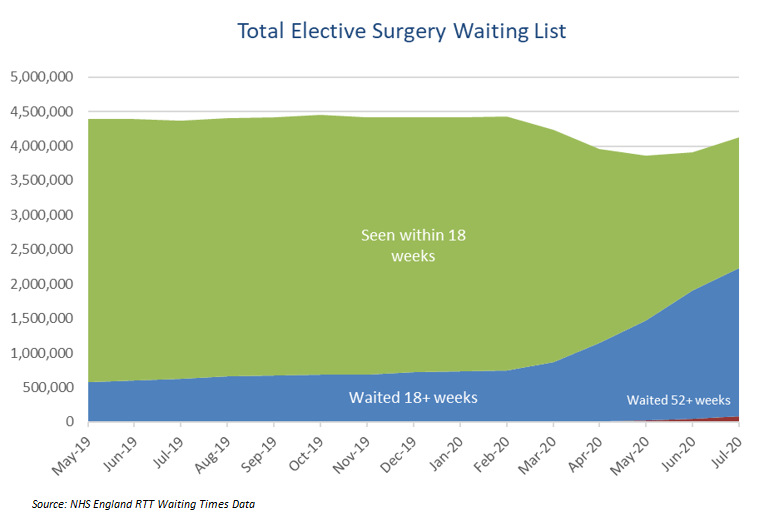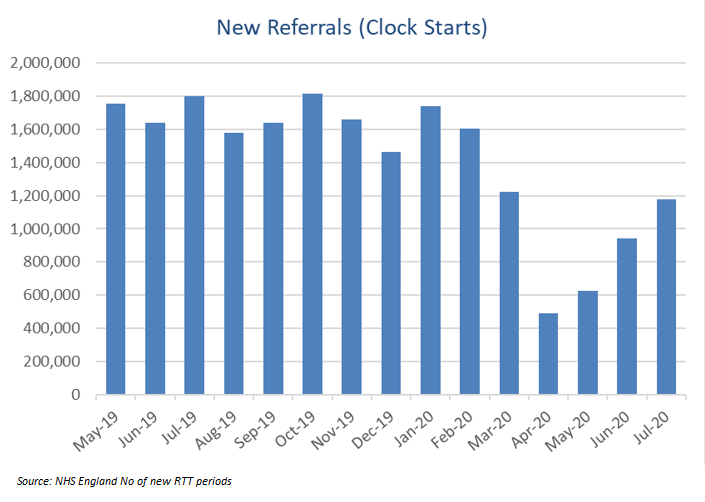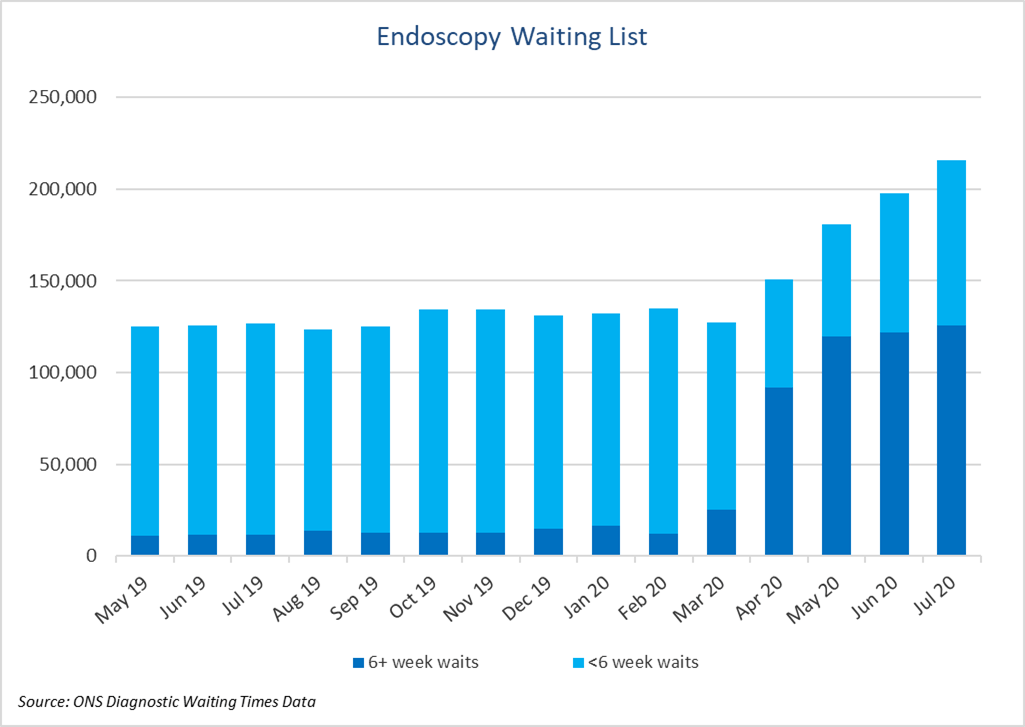Es sieht so aus, als wären Sie in den Vereinigten Staaten
Wir haben eine andere Website (www.q-bital.com), die besser zu Ihrem Standort passt
Die Wartezeiten für geplante chirurgische Eingriffe und Diagnoseverfahren steigen immer weiter an. Was kann getan werden, um den Rückstand aufzuholen?
Die neuesten vom NHS England veröffentlichten Zahlen, die den Zeitraum bis Juli 2020 abdecken, zeigen, dass die Wartezeiten trotz der nach wie vor niedrigen Zahl neuer Überweisungen und steigender Aktivität weiterhin rapide angestiegen sind.
Wie die Grafik zeigt, ist die Gesamtzahl der Wartelisten im März und April vorübergehend gesunken, was hauptsächlich auf einen Rückgang der Überweisungen zurückzuführen ist. Jetzt steigt sie jedoch langsam, aber stetig an. Noch wichtiger ist jedoch, dass die Wartezeiten der Patienten auf eine Behandlung erheblich zugenommen haben.
 Im Juli war die Zahl der Menschen, die länger als 18 Wochen auf Wartelisten standen, mit 2,15 Millionen so hoch wie nie zuvor. Das bedeutet, dass mehr als die Hälfte der Wartenden – 53% – länger als 18 Wochen auf eine Behandlung warten. Vor der Pandemie lag dieser Prozentsatz in einem „normalen“ Monat bei etwa 13-14% der Gesamtzahl.
Im Juli war die Zahl der Menschen, die länger als 18 Wochen auf Wartelisten standen, mit 2,15 Millionen so hoch wie nie zuvor. Das bedeutet, dass mehr als die Hälfte der Wartenden – 53% – länger als 18 Wochen auf eine Behandlung warten. Vor der Pandemie lag dieser Prozentsatz in einem „normalen“ Monat bei etwa 13-14% der Gesamtzahl.
Darüber hinaus warteten bis Juli 2020 mehr als 83.000 Patienten länger als ein Jahr auf eine Behandlung. Dies war ein erheblicher Anstieg im Vergleich zum Vorjahr und stellte die höchste Zahl von 52-wöchigen Wartezeiten seit 2008 dar.
Obwohl die Daten auch positive Aspekte aufweisen, wie etwa dass das Aktivitätsniveau im Allgemeinen und die Zahl der neuen Überweisungen gestiegen sind, ist es noch ein weiter Weg. Im Juli lag die Zahl der freiwilligen Aufnahmen trotz eines deutlichen Anstiegs bei weniger als der Hälfte der Zahl vom Vorjahr.
Die Zahl der Neuzuweisungen ist seit Mai stark gestiegen, liegt aber immer noch weit unter dem Normalniveau und es scheint, dass die erwarteten aufgeschobenen Zuweisungen aus dem Zeitraum März bis Juni noch nicht erfolgt sind.
 In einer kürzlichen
Artikel im BMJ
Neil Mortensen, Präsident des Royal College of Surgeons of England, wurde mit den Worten zitiert, er sei enttäuscht darüber, dass die Wartelisten im Juli länger geworden seien, zwei Monate nachdem der NHS einen Fahrplan zur Wiederherstellung der Routineversorgung veröffentlicht hatte.
In einer kürzlichen
Artikel im BMJ
Neil Mortensen, Präsident des Royal College of Surgeons of England, wurde mit den Worten zitiert, er sei enttäuscht darüber, dass die Wartelisten im Juli länger geworden seien, zwei Monate nachdem der NHS einen Fahrplan zur Wiederherstellung der Routineversorgung veröffentlicht hatte.
Er sagte: „Wir müssen unsere Krankenhausreserven dringend aufstocken, wenn wir diesen Winter überstehen wollen. Die Grippe und die anhaltenden lokalen Covid-19-Ausbrüche dürfen nicht dazu führen, dass der OP-Betrieb erneut zum Erliegen kommt, sonst werden Tausende weitere leiden.“ Dies verdeutlicht die Schwere des Problems und die mangelnde Widerstandsfähigkeit in weiten Teilen des britischen Gesundheitswesens.
Die neuesten Endoskopiedaten zeigten ein ähnliches Bild. Es wurden mehr Endoskopien und Gastroskopien durchgeführt, wobei sich die Aktivitätsniveaus im Juni mehr als verdoppelten und im Juli um weitere 451 TP4T zunahmen, aber selbst dann blieb die Aktivität weit unter dem normalen Niveau.
Die Gesamtzahl der Menschen, die im Juli 2020 auf eine Endoskopie warteten, lag bei rund 216.000 – ein Anstieg um 701 TP4T im Vergleich zum Juli des Vorjahres, und das Wachstum zeigt keine Anzeichen einer Verlangsamung.
 Während sich die Zahl der Menschen, die länger als 18 Wochen warten, zwischen Mai und Juli stabilisiert hat, ist das Niveau ungewöhnlich hoch, und unter diesen Patienten werden viele sein, deren Wartezeit sich über 18 Wochen hinaus verlängert. Im Juli warteten rund 126.000 Menschen – mehr als die Hälfte derjenigen, die auf eine Endoskopie warteten – über 18 Wochen, verglichen mit rund 12.000 vor einem Jahr.
Während sich die Zahl der Menschen, die länger als 18 Wochen warten, zwischen Mai und Juli stabilisiert hat, ist das Niveau ungewöhnlich hoch, und unter diesen Patienten werden viele sein, deren Wartezeit sich über 18 Wochen hinaus verlängert. Im Juli warteten rund 126.000 Menschen – mehr als die Hälfte derjenigen, die auf eine Endoskopie warteten – über 18 Wochen, verglichen mit rund 12.000 vor einem Jahr.
Diese Zahlen sind alarmierend, aber nicht unerwartet. Obwohl die Aktivität im August und September wahrscheinlich weiter zugenommen hat, bleibt abzuwarten, ob sich dies auf die Wartezeiten ausgewirkt hat.
Gleichzeitig deuten die Zahlen darauf hin, dass uns eine herausfordernde Herbst- und Wintersaison bevorstehen könnte und dass es unglaublich schwierig sein wird, den Rückstand aufzuholen. Die langsame Erholung der Warteliste für Wahlfächer gibt einen Hinweis darauf, wie lange es dauern könnte, bis das volle Ausmaß der aufgeschobenen Nachfrage aus der Lockdown-Zeit überhaupt erkannt wird.
So oder so muss die Kapazität erheblich gesteigert werden, wenn das NHS überhaupt eine Chance haben soll, die Wartezeiten für elektive Behandlungen und Verfahren zu verkürzen. Flexible Gesundheitsinfrastruktur, wie mobile und modulare Operationssäle und Behandlungsräume können eine schnelle und effektive Lösung für immer längere Wartelisten bieten.
Klar ist auch, dass diese Situation noch längere Zeit andauern wird und mehr als eine kurzfristige Lösung erfordert. Ein modulares Gebäude, das einen Operationssaal, einen Behandlungsraum oder eine Krankenstation beherbergt, kann innerhalb kürzester Zeit nahezu dauerhaft gebaut werden und kann zudem so konfiguriert und fertiggestellt werden, dass es den Anforderungen jedes Kunden entspricht. Ein solches Gebäude bietet zusätzlichen Platz für Covid-Light und zusätzliche Sicherheit für die Patienten, indem es einen völlig separaten Eingangs- und Empfangsbereich sowie einen separaten Patientenweg zum Hauptkrankenhaus bietet.



Vanguard Healthcare-Lösungen
Einheit 1144 Regent Court, The Square, Gloucester Business Park, Gloucester, GL3 4AD

Wir haben eine andere Website (www.q-bital.com), die besser zu Ihrem Standort passt